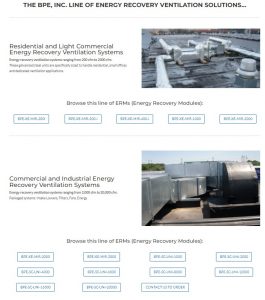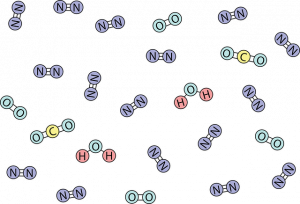Okay, so it isn’t exactly our challenge; technically, the Clean Air in Buildings Challenge comes from the EPA and the White House. We do stand behind it, however, and we certainly enjoy helping building owners and managers heed the call.
When COVID-19 came along, more people took notice of the need for better indoor air and ample ventilation. However, that need had been there all along—and became more critical after the energy crisis of the 70s when building envelopes became ever tighter. After all, they didn’t call the resulting lack of outdoor air Sick Building Syndrome for nothing.
So how can you meet the Clean Air in Buildings Challenge?
The EPA wants you to create a clean indoor air action plan.
Among its recommendations, the EPA encourages you to work with an HVAC professional to assess current indoor air quality and how it comes into the building. Is there enough clean airflow (outdoor air plus filtered HVAC recirculation air)? Is that air reaching areas with higher demand such as medical offices or manufacturing zones? What improvements and upgrades can you make to your current heating, cooling, and ventilation systems?
While formulating a plan, remember that when public transmission of disease is higher, it might be necessary to use more energy to boost ventilation, increasing air exchanges—possibly resulting in larger energy bills. Is it worth the cost? Nothing eliminates disease risk 100% and measures such as handwashing and staying home when sick are as necessary as ever, but effective HVAC can reduce viral transmission risk dramatically.
Once you come up with a plan, don’t forget to establish a schedule for regular inspections so that proper maintenance doesn’t lag, and filtration stays optimal. Be sure the right members of the building community know how to use new systems and how to modify procedures when necessary.
 A note from BPE: Looking for that HVAC pro? It’s our mission to offer people the most healthful indoor environments possible. We want healthier circumstances for the planet, too, so our solutions aim to reduce emissions as much as possible. From the smallest of spaces to indoor environments rife for germ transmission, we think sustainably for the sake of human health, the planet, and energy budgets.
A note from BPE: Looking for that HVAC pro? It’s our mission to offer people the most healthful indoor environments possible. We want healthier circumstances for the planet, too, so our solutions aim to reduce emissions as much as possible. From the smallest of spaces to indoor environments rife for germ transmission, we think sustainably for the sake of human health, the planet, and energy budgets.
The EPA advises you to optimize your fresh air ventilation.
 Optimization begins by bringing acceptably clean or properly filtered outdoor air into your building. Run HVAC during all occupied hours for proper distribution and consider doing so one to two hours before and after occupancy. Are all bathroom exhaust fans operational and running along with the HVAC? Consider opening windows and doors when weather and safety permit; the cross-ventilation during periods of heightened disease may be worth the extra energy cost incurred as HVAC compensates.
Optimization begins by bringing acceptably clean or properly filtered outdoor air into your building. Run HVAC during all occupied hours for proper distribution and consider doing so one to two hours before and after occupancy. Are all bathroom exhaust fans operational and running along with the HVAC? Consider opening windows and doors when weather and safety permit; the cross-ventilation during periods of heightened disease may be worth the extra energy cost incurred as HVAC compensates.
A note from BPE: High-performance energy recovery ventilation can more effectively displace indoor air and its contaminants with outdoor air instead of dispersing the stale air willy-nilly. When boosting ventilation oomph to fight heightened viral loads or to ensure thermal comfort despite extreme heat or cold outdoors, the heat energy recovery used by energy recovery ventilators (ERVs) can minimize additional energy dollars. Now, by high performance, we’re talking typical thermal efficiencies of 80% on up to 90+%. We mean Energy Efficiency Ratios (EER) between 36 and 160 while 10 is typical of the industry. Plus, on average, BPE ERVs pay for themselves within two years. Sound good so far? From our smallest units to stackable modules that serve industrial complexes and arenas, we’re certain our ‘Long Ass ERVs’ can improve your HVAC system in bringing outdoor air in as effectively and efficiently as possible.
The EPA reminds you to enhance air filtration and cleaning.
Install the highest-rated MERV filters your HVAC system can handle—or at least MERV-13. Minimize air seeping around filters by sealing off any gaps.
If your HVAC is not highly efficient and/or certain spaces within the building are prone to poor airflow or higher particle and aerosol emissions, add portable air cleaners (preferably ENERGY STAR®-certified products) of suitable size where necessary. As well, you might want to have that extra stale air move directly outside.
Upper-room Ultraviolet Germicidal Irradiation (UVGI) is a consideration no matter how stellar your HVAC system. You’ll want to speak to UVGI experts before undergoing design and installation.
A note from BPE: Wondering which indoor spaces may require more airflow? Consult ASHRAE Standard 62.1: Ventilation for Acceptable Indoor Air Quality. And take the EPA’s thoughts on UVGI seriously, especially for medical offices, hospitals, and school buildings.
The EPA urges community involvement in your action plan.
Bring your clean air action plan to the attention of building occupants so that they can’t help but become party to it. Relay steps and expectations via building walkthroughs, signage, and social media. Does management know how to control equipment? Do office workers understand blocking air vents affects everyone?
Stress the importance of personal accountability in prevention strategies that reduce sicknesses such as COVID-19. Encourage feedback through surveys so occupants recognize their thoughts and commitment matter. Facilitate maintenance requests to deal with repairs swiftly.
A note from BPE: More people come together when the need for their cooperation is clear and they see it is appreciated. And that cooperation is vital, because at BPE, we know buildings that successfully retrofit or build new to operate clean and sustainable HVAC accomplish at least three things:
- Clean, comfortable indoor air that results in better human health, cognition, and productivity.
- Contribution to a healthier planet due to fewer emissions bolstering global warming.
- Lower energy bills so companies can push dollars towards more satisfying goals.
We’d like to think most people care about at least one (and hopefully all) of those goals, and we challenge you to discover how your property can reap the same rewards. Simply give us a call to start!


